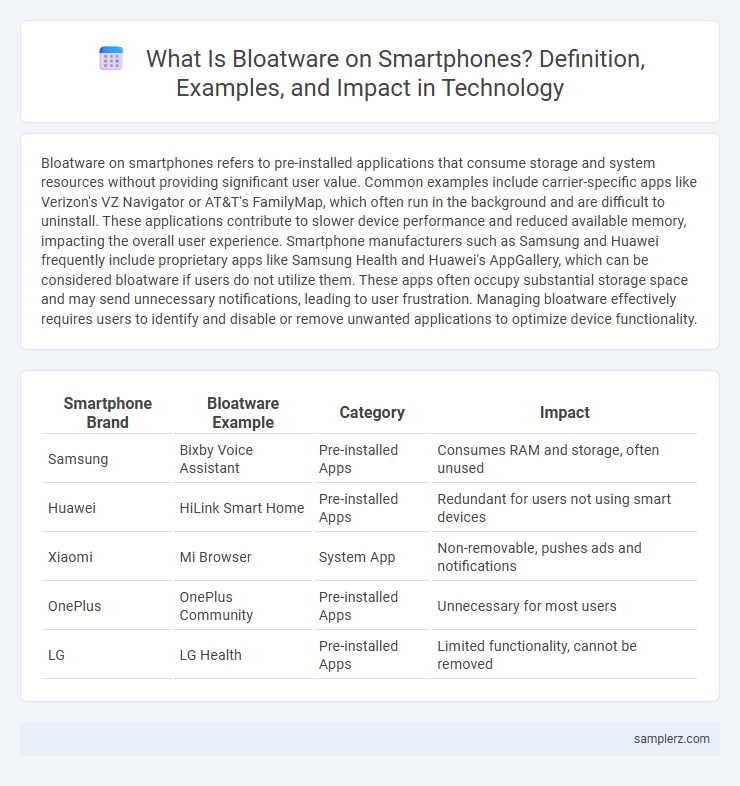Bloatware on smartphones refers to pre-installed applications that consume storage and system resources without providing significant user value. Common examples include carrier-specific apps like Verizon's VZ Navigator or AT&T's FamilyMap, which often run in the background and are difficult to uninstall. These applications contribute to slower device performance and reduced available memory, impacting the overall user experience. Smartphone manufacturers such as Samsung and Huawei frequently include proprietary apps like Samsung Health and Huawei's AppGallery, which can be considered bloatware if users do not utilize them. These apps often occupy substantial storage space and may send unnecessary notifications, leading to user frustration. Managing bloatware effectively requires users to identify and disable or remove unwanted applications to optimize device functionality.
Table of Comparison
| Smartphone Brand | Bloatware Example | Category | Impact |
|---|---|---|---|
| Samsung | Bixby Voice Assistant | Pre-installed Apps | Consumes RAM and storage, often unused |
| Huawei | HiLink Smart Home | Pre-installed Apps | Redundant for users not using smart devices |
| Xiaomi | Mi Browser | System App | Non-removable, pushes ads and notifications |
| OnePlus | OnePlus Community | Pre-installed Apps | Unnecessary for most users |
| LG | LG Health | Pre-installed Apps | Limited functionality, cannot be removed |
Understanding Bloatware: What Is It and Why Does It Matter?
Bloatware refers to pre-installed applications on smartphones that consume storage and system resources without providing significant user value, such as carrier-specific apps or trial versions of software. These apps can slow down device performance, reduce battery life, and limit available storage, impacting the overall user experience. Identifying and managing bloatware is crucial for optimizing smartphone functionality and maintaining efficient device operation.
Common Types of Bloatware Found on Smartphones
Common types of bloatware found on smartphones include pre-installed carrier apps, manufacturer-specific utilities, and redundant social media platforms. These apps often consume valuable storage space and run background processes that can slow down device performance. Removing or disabling bloatware can improve battery life and increase overall system responsiveness.
Pre-installed Carrier Apps: Unwanted Smartphone Bloatware
Pre-installed carrier apps often serve as prime examples of smartphone bloatware, consuming storage and system resources without user consent. These apps, such as Verizon Navigator or AT&T Locker, rarely provide valuable functions, leading to reduced device performance and user frustration. Smartphone manufacturers and carriers frequently bundle these applications, making removal difficult and compromising overall user experience.
Manufacturer Bloatware: Built-in Features You Don’t Need
Manufacturer bloatware refers to pre-installed apps and features by smartphone makers that often consume unnecessary storage and system resources, such as Samsung's Galaxy Store or Huawei's AppGallery. These built-in applications can slow down device performance and limit user customization options. Removing or disabling such bloatware enhances device speed and frees up valuable memory for essential apps.
Social Media Apps as Bloatware Examples
Social media apps such as Facebook, Instagram, and Snapchat are common examples of bloatware on many smartphones, pre-installed by manufacturers or carriers. These apps consume significant storage space, drain battery life, and often run background processes that slow down device performance. Users frequently face difficulties uninstalling or disabling these social media applications, leading to unnecessary resource consumption and reduced phone efficiency.
Utility and Security Apps: Helpful or Just Bloatware?
Utility and security apps pre-installed on smartphones often serve essential functions like device optimization and malware protection, but many users find them redundant or resource-heavy. Examples include carrier-specific antivirus programs and system cleaners that duplicate built-in Android or iOS features, consuming storage and battery life without added value. Evaluating these apps critically helps determine whether they enhance security or simply contribute to bloatware clutter.
Impact of Bloatware on Smartphone Performance
Bloatware such as pre-installed social media apps and trial games consume valuable storage space and drain RAM, significantly slowing down smartphone performance. These unnecessary applications increase system boot time and cause frequent app crashes, reducing overall device responsiveness. Users often face rapid battery depletion and diminished browsing speed due to the excessive background activity initiated by bloatware.
How Bloatware Affects Storage and Battery Life
Pre-installed bloatware like Samsung's proprietary apps and carrier-specific software consume significant internal storage, reducing available space for user data and applications. These background apps often run persistently, increasing CPU utilization and draining battery life faster than necessary. Removing or disabling bloatware can improve device performance, freeing up storage and extending battery longevity.
Identifying and Removing Bloatware Safely
Bloatware refers to pre-installed apps on smartphones that consume storage and system resources without providing significant user value, such as carrier-specific tools or redundant utilities. Identifying bloatware involves reviewing app permissions, usage frequency, and impact on device performance through built-in settings or third-party diagnostic tools. Removing bloatware safely requires disabling or uninstalling non-essential apps using device settings or trusted software, ensuring stability and security are maintained.
Best Practices to Avoid Bloatware on New Smartphones
Pre-installing essential apps from trusted developers can minimize bloatware on smartphones, ensuring better device performance and user experience. Utilizing custom ROMs or smartphones that emphasize clean operating systems helps avoid unnecessary default apps. Regularly reviewing and uninstalling unused pre-installed applications further optimizes storage and enhances device speed.

example of bloatware in smartphone Infographic
 samplerz.com
samplerz.com